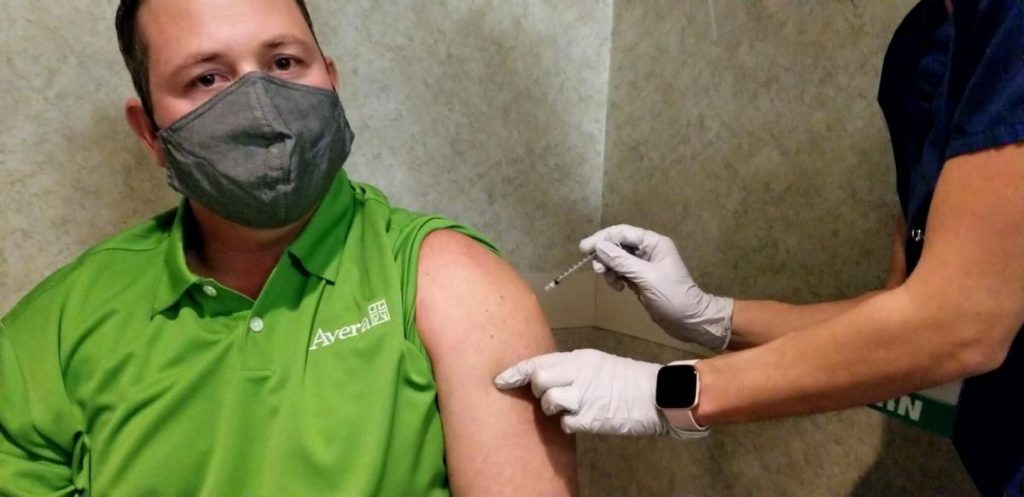
Dr. Adam LeFebvre, an anesthesiologist at Avera St. Luke’s Hospital, receives his COVID-19 shot Tuesday evening. (courtesy photo)
ABERDEEN, S.D. (By Elisa Sand [email protected]) – Christmas came a little early for some of the medical personnel at Avera St. Luke’s Hospital and Sanford Aberdeen Medical Center this week.
Both hospitals received their first deliveries of COVID-19 vaccine. Avera St. Luke’s received 1,000 doses, according to the hospital media relations team. The first were given Tuesday in one of four planned distribution events for employees this week. Some of these first shots also went to local first responders.
Another 400 doses arrived at Sanford Aberdeen where distribution events were planned Wednesday and Thursday with more next week as additional vaccine is delivered.
Kila Legrand, director of nursing and clinical services at Sanford Aberdeen, said Sanford could have received more doses, but chose a lesser amount because it is a holiday week.
“We wanted to be frugal with our supply,” Legrand said, adding that just knowing the vaccine is coming and planning distribution lifted sprits.
“It was like Christmas came early,” she said.
Hospitals now have two vaccines available for distribution — one made by Pfizer-BioNTech and another made by Moderna. Both companies have received approval and emergency use authorization through the Federal Drug Administration. The Moderna vaccine, approved last week, was shipped to both Aberdeen hospitals.
Excitement abounds
In interviews Thursday, Dr. Adam LeFebvre, an anesthesiologist at Avera St. Luke’s, and Dr. Lyle Biegler, chief of staff at State Street Medical Square, said they were both excited knowing the first doses are in town.
“It’s very exciting,” LeFebvre said. “It’s pretty incredible what they’ve been able to accomplish in just a year’s time.”
He said companies started product development hoping the vaccine would be 50% effective, so having a product that’s 90% effective is impressive.
While it seems like development happened quickly, LeFebvre said, the companies developing the vaccines are taking advantage of developments with science and technology that have become available in recent years. And, he said, the developments will help treatment of other diseases as well.
“It’s not new technology,” LeFebvre said. “Companies have been working on this way a long time and developing a lot of techniques. It’s amazing what happens when you get the resources and the whole world is working toward one goal.”
The lingering question, he said, is the long-term effectiveness of the vaccine.
Companies are issuing the COVID-19 vaccines as a series of two shots, with the second given 21 or 28 days after the first. That second shot boosts effectiveness from 60% to 90%, Biegler said. LeFebvre said companies have yet to determine how long the shot offers protection. That will take more time.
The side effects appear minimal at this time — a sore arm, headache or other symptoms one might experience after receiving a flu shot, they said.
“It’s just a sign that your immune system is ramping up,” LeFebvre said.
“You’re going to know you got the shot,” Biegler said. “It’s worth it. The most common side effect is a sore arm.”
That happens with 80% who receive the vaccine, Biegler said, and 60% experience aches and a headache, both of which are considered mild symptoms.
“Everyone who’s gotten it in Sioux Falls says it’s not that bad,” Biegler said. “Anecdotally, front line workers are reporting no side effects or a sore arm.”
LeFebvre said he can’t wait to get vaccinated.
“As soon as I can get it, I’m going to get it,” he said.”I want to be able to protect my family. The science behind it is very good. This is our road back to normal.”
Legrand said she hasn’t yet signed up for a time slot to receive the vaccine. Instead, she elected to be on standby. Each container of vaccine has 10 doses inside, she said, so vaccinations are scheduled in increments of 10. If there’s a cancellation and someone needs to jump in, she’ll be there.
After months of the virus circulating, Biegler said that by now everyone is likely to have a story about a parent or relative who has had COVID-19 and doesn’t feel well now. That might convince people to get the vaccine.
“I just want to get this vaccine and get back to normal,” he said. “It’s going to take a vaccine to get things better. I don’t see it going away until 70% of the population gets it.”
Biegler said he has elderly patients who are scared of getting COVID-19 and dying.
“I want to get it as an example for my patients,” he said. “I want to get it before I see my in-laws for Christmas.”
A painless shot
Both Biegler and LeFebvre received shots at Avera’s first distribution event Tuesday evening. Both said the shots were painless, and neither had any adverse reactions, according to comments sent by email through Avera’s media relations.
Biegler compared the experience to that of receiving a flu shot. He said he there was a feeling of pure joy after receiving the shot.
“I’m just grateful. But also feeling a little guilty,” he said about being among the first to get vaccinated. “There’s a combination of guilt and gratefulness. I wish everyone could get it. But once we break the seal on this, I think it’s going to go pretty well.”
“It’s kind of crazy to get the vaccine in just 10 months,” LeFebvre said after receiving the shot. “I feel fortunate to be one of the first in town to receive it.”
Protection still important
Hospitalizations have decreased in recent days, providing some relief locally, Biegler said. More than anything, he wants to file fewer death summaries for his patients.
Those at the hospitals working closest with COVID-19 patients or at the highest risk of being exposed to COVID-19 are the priority when it comes to the first vaccinations. The same is true of long-term care staff.
Residents in long-term care facilities will be next for vaccinations. Then, priority will be given to those who are 65 or older or have chronic medical conditions like cancer, chronic obstructive pulmonary disease, kidney disease, heart disease or diabetes and those who have a compromised immune system.
Eventually, vaccinations will be available to the general population, though Legrand said estimates from federal experts are that it won’t be until the second quarter of 2021.
While vaccinations being available is good news, LeFebvre, Biegler and Legrand said safety precautions continue to be important until enough people get their shots.
It’s still important to wear a mask, social distance and wash hands frequently, they said.
“Even those who are vaccinated should do all those things,” LeFebvre said. “Until more people get vaccinated.”
Biegler also encourages people to seek out trusted sources of information about the vaccine, like local hospitals, the World Health Organization, the CDC, the Advisory Committee on Immunization Practices and the American Academy of Family Physicians. He hopes people don’t fall for misinformation that’s spreading on social media.
Bogus claims include that the vaccine will change a person’s DNA or that it is unethically manufactured. Both, Biegler said, are false. The vaccine is developed using messenger DNA, which introduces cells that look like the virus.
He said claims about unethical manufacturing have been vetted by the hospital.
“At Avera, we take that very seriously. That’s been looked into by our ethics committee. They found nothing to say this was an unsafe or unethical vaccine,” Biegler said.
(visit www.aberdeennews.com)







